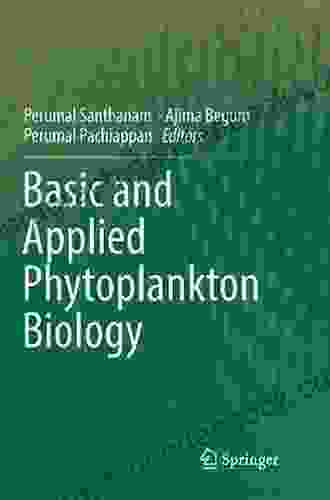Basic and Applied Phytoplankton Biology: A Comprehensive Overview

Phytoplankton are single-celled microscopic algae that form the foundation of aquatic food webs and play a crucial role in global carbon cycling. Understanding their biology is essential for managing aquatic ecosystems and mitigating climate change. This article provides a comprehensive overview of basic and applied phytoplankton biology, covering their diversity, distribution, physiology, ecology, and significance in the environment and biotechnology.
Phytoplankton are classified into various divisions based on their photosynthetic pigments and cell structure. The major groups include:
- Chlorophyta: Green algae with chloroplast containing chlorophyll a and b.
- Chrysophyta: Golden-brown algae with chloroplasts containing chlorophyll a and c.
- Bacillariophyta: Diatoms with glass-like cell walls made of silica.
- Pyrrophyta: Dinoflagellates with complex life cycles and bioluminescent capabilities.
- Euglenophyta: Mixotrophic algae capable of both photosynthesis and heterotrophic feeding.
Phytoplankton are found in all aquatic environments, from freshwater lakes and rivers to marine oceans. Their distribution is influenced by environmental factors such as light, nutrients, temperature, and salinity.
4.6 out of 5
| Language | : | English |
| File size | : | 21943 KB |
| Text-to-Speech | : | Enabled |
| Screen Reader | : | Supported |
| Enhanced typesetting | : | Enabled |
| Print length | : | 471 pages |
Phytoplankton are autotrophs that convert sunlight, carbon dioxide, and water into organic compounds through photosynthesis. They are composed primarily of water, protein, carbohydrates, and lipids. Their cell structure includes a nucleus, chloroplasts, vacuoles, and various organelles.
Phytoplankton have adapted to diverse environmental conditions through physiological mechanisms. They can regulate their buoyancy, adjust their photosynthetic rates, and store energy reserves in the form of lipids.
Phytoplankton are primary producers in aquatic ecosystems, forming the base of food chains. They are grazed by zooplankton, which are in turn consumed by fish and other larger organisms. Phytoplankton play a crucial role in nutrient cycling, releasing dissolved organic matter and remineralizing nutrients that are available to other organisms.
Phytoplankton blooms, characterized by rapid growth and high abundance, are common in aquatic environments. Blooms can be beneficial, providing food for higher trophic levels and supporting ecosystem functioning. However, excessive blooms can cause water quality issues such as oxygen depletion and toxin production.
Phytoplankton have fundamental ecological and economic importance. They are:
- Primary producers: They fix carbon dioxide and produce oxygen, contributing to global carbon cycling.
- Food source: They provide nutrition for aquatic organisms at all trophic levels, supporting fisheries and aquaculture.
- Water quality indicators: Changes in phytoplankton abundance and species composition can indicate environmental disturbances and water pollution.
- Biofuel production: Certain species of phytoplankton have high lipid content and are being investigated for biofuel production.
- Pharmaceuticals and cosmetics: Phytoplankton extracts have potential applications in pharmaceuticals and cosmetics due to their antioxidant and anti-inflammatory properties.
Applied phytoplankton biology focuses on the practical applications of phytoplankton knowledge. Key areas include:
- Aquaculture:** Optimizing phytoplankton culture techniques for fish and shellfish production.
- Bioremediation:** Using phytoplankton to remove pollutants from wastewater and contaminated water bodies.
- Carbon sequestration: Exploring the potential of phytoplankton to mitigate climate change by enhancing carbon sequestration.
- Phytoplankton monitoring: Developing methods for monitoring phytoplankton abundance and diversity to assess water quality and track environmental changes.
- Phycotoxins: Studying the production and detection of toxins produced by harmful algal blooms to protect human and animal health.
Phytoplankton biology is a rapidly growing field of study with significant implications for understanding aquatic ecosystems, mitigating climate change, and supporting various industries. By continuing to unravel the intricacies of phytoplankton biology, we can enhance our ability to manage aquatic resources, protect water quality, and harness the potential of these tiny organisms for sustainable development.
:
An illustration of phytoplankton, microscopic algae that are the foundation of aquatic food webs and play a crucial role in global carbon cycling.
4.6 out of 5
| Language | : | English |
| File size | : | 21943 KB |
| Text-to-Speech | : | Enabled |
| Screen Reader | : | Supported |
| Enhanced typesetting | : | Enabled |
| Print length | : | 471 pages |
Do you want to contribute by writing guest posts on this blog?
Please contact us and send us a resume of previous articles that you have written.
 Book
Book Novel
Novel Text
Text Story
Story Reader
Reader Library
Library Paperback
Paperback Magazine
Magazine Paragraph
Paragraph Sentence
Sentence Bibliography
Bibliography Foreword
Foreword Preface
Preface Annotation
Annotation Footnote
Footnote Manuscript
Manuscript Scroll
Scroll Tome
Tome Library card
Library card Narrative
Narrative Autobiography
Autobiography Encyclopedia
Encyclopedia Dictionary
Dictionary Thesaurus
Thesaurus Narrator
Narrator Resolution
Resolution Librarian
Librarian Catalog
Catalog Archives
Archives Study
Study Lending
Lending Reserve
Reserve Journals
Journals Rare Books
Rare Books Special Collections
Special Collections Literacy
Literacy Study Group
Study Group Storytelling
Storytelling Theory
Theory Textbooks
Textbooks Kimberley Lovato
Kimberley Lovato Minki Kim
Minki Kim Eric Salzman
Eric Salzman Patrick Lose
Patrick Lose Propaganda
Propaganda Bob Seger
Bob Seger Mike Morgan
Mike Morgan Nathan Myhrvold
Nathan Myhrvold Susan Conant
Susan Conant Nick Joaquin
Nick Joaquin E E Cummings
E E Cummings C L Kagmi
C L Kagmi Rebecca Makkai
Rebecca Makkai Jeffrey D Simon
Jeffrey D Simon Chloe Timperley
Chloe Timperley Stacia Deutsch
Stacia Deutsch Seamus Bruner
Seamus Bruner Joan Jefferson Freeman
Joan Jefferson Freeman Steve Herman
Steve Herman Stephen J King
Stephen J King
Light bulbAdvertise smarter! Our strategic ad space ensures maximum exposure. Reserve your spot today!

 Ronald SimmonsUnveiling the Gripping Psychological Thriller: A Labyrinth of Twists and...
Ronald SimmonsUnveiling the Gripping Psychological Thriller: A Labyrinth of Twists and... Howard PowellFollow ·6.1k
Howard PowellFollow ·6.1k Benji PowellFollow ·8.9k
Benji PowellFollow ·8.9k Jim CoxFollow ·3.2k
Jim CoxFollow ·3.2k Michael SimmonsFollow ·9.3k
Michael SimmonsFollow ·9.3k Pete BlairFollow ·10.6k
Pete BlairFollow ·10.6k Henry GreenFollow ·3.4k
Henry GreenFollow ·3.4k Fletcher MitchellFollow ·7.2k
Fletcher MitchellFollow ·7.2k Jedidiah HayesFollow ·6.1k
Jedidiah HayesFollow ·6.1k

 Ricky Bell
Ricky BellThe Marriage: An Absolutely Jaw-Dropping Psychological...
In the realm of...

 Ray Blair
Ray BlairDiscover the Enchanting Charm of Budapest and Its...
Nestled in the heart of...

 Tyrone Powell
Tyrone PowellHuddle: How Women Unlock Their Collective Power
Huddle is a global movement that empowers...

 Grayson Bell
Grayson BellThe Coin Story of the Holocaust: A Symbol of Hope and...
In the depths of the...

 Virginia Woolf
Virginia WoolfFolklore Performance and Identity in Cuzco, Peru: A...
Nestled amidst...

 Dylan Mitchell
Dylan MitchellThe Enduring Love Story of Héloïse and Abélard: A Tale of...
An Intellectual Passion In the heart of...
4.6 out of 5
| Language | : | English |
| File size | : | 21943 KB |
| Text-to-Speech | : | Enabled |
| Screen Reader | : | Supported |
| Enhanced typesetting | : | Enabled |
| Print length | : | 471 pages |










